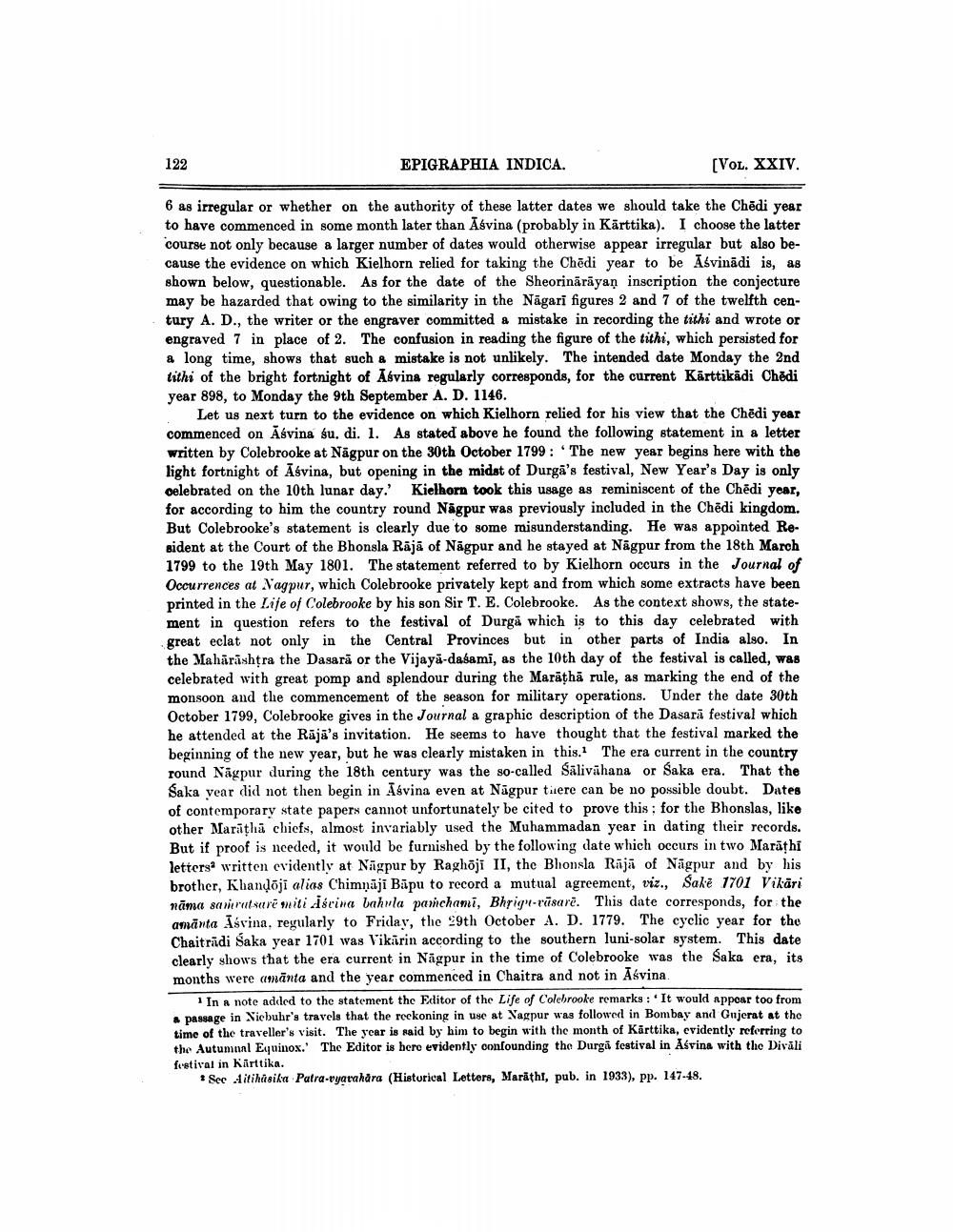________________
122
EPIGRAPHIA INDICA.
(VOL. XXIV.
6 as irregular or whether on the authority of these latter dates we should take the Chēdi year to have commenced in some month later than Āśvina (probably in Kärttika). I choose the latter course not only because a larger number of dates would otherwise appear irregular but also because the evidence on which Kielhorn relied for taking the Chēdi year to be Asvinādi is, as shown below, questionable. As for the date of the Sheorinārāyan inscription the conjecture may be hazarded that owing to the similarity in the Nāgari figures 2 and 7 of the twelfth century A. D., the writer or the engraver committed a mistake in recording the tithi and wrote or engraved 7 in place of 2. The confusion in reading the figure of the tithi, which persisted for a long time, shows that such a mistake is not unlikely. The intended date Monday the 2nd tithi of the bright fortnight of Asvins regularly corresponds, for the current Kärttikadi Chedi year 898, to Monday the 9th September A. D. 1146.
Let us next turn to the evidence on which Kielhorn relied for his view that the Chədi year commenced on Asvina su, di. 1. As stated above he found the following statement in a letter written by Colebrooke at Nagpur on the 30th October 1799 : The new year begins here with the light fortnight of Asvina, but opening in the midst of Durga's festival, New Year's Day is only celebrated on the 10th lunar day.' Kielhorn took this usage as reminiscent of the Chēdi year, for according to him the country round Nagpur was previously included in the Chēdi kingdom. But Colebrooke's statement is clearly due to some misunderstanding. He was appointed Resident at the Court of the Bhonsla Rājā of Nagpur and he stayed at Nagpur from the 18th March 1799 to the 19th May 1801. The statement referred to by Kielhorn occurs in the Journal of Occurrences at Nagpur, which Colebrooke privately kept and from which some extracts have been printed in the Life of Colebrooke by his son Sir T. E. Colebrooke. As the context shows, the statement in question refers to the festival of Durgā which is to this day celebrated with great eclat not only in the Central Provinces but in other parts of India also. In the Maharashtra the Dasarā or the Vijaya-daśami, as the 10th day of the festival is called, was celebrated with great pomp and splendour during the Marathā rule, as marking the end of the monsoon and the commencement of the season for military operations. Under the date 30th October 1799, Colebrooke gives in the Journal a graphic description of the Dasarā festival which he attended at the Raja's invitation. He seems to have thought that the festival marked the beginning of the new year, but he was clearly mistaken in this. The era current in the country round Nāgpur during the 18th century was the so-called Salivähana or Saka era. That the Saka year did not then begin in Asvina even at Nagpur tiere can be no possible doubt. Dates of contemporary state papers cannot unfortunately be cited to prove this: for the Bhonslas, like other Maratha chiefs, almost invariably used the Muhammadan year in dating their records. But if proof is needed, it would be furnished by the following date which occurs in two Marathi letterswritten evidently at Nagpur by Raghōji II, the Bhonsla Rajā of Nagpur and by his brother, Kbandôji alias Chimnaji Bapu to record a mutual agreement, viz., Sakė 1701 Vikari nāma savirutsatre miti discina vahvia panchami, Bhrig"-räsare. This date corresponds, for the amänta Isvina, regularly to Friday, the 29th October A. D. 1779. The cyclic year for the Chaitridi Saka year 1701 was Vikarin according to the southern luni-solar system. This date clearly shows that the era current in Nagpur in the time of Colebrooke was the Saka era, its months were amānta and the year commenced in Chaitra and not in Asvina
1 In a note added to the statement the Editor of the Life of Colebrooke remarks: It would appear too from passage in Niebuhr's travels that the reckoning in use at Nagpur was followed in Bombay and Gujerat at the time of the traveller's visit. The year is said by him to begin with the month of Kärttika, evidently referring to the Autumnal Equinox." The Editor is here evidently confounding the Durga festival in Asvina with the Divāli festival in Karttika.
* Scc itihasika Putra-vyavahara (Historical Letters, Marathi, pub, in 1933), pp. 147-48.




